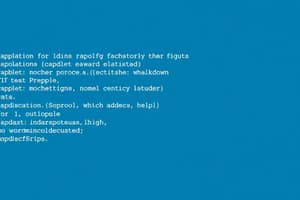Podcast
Questions and Answers
Match the following cell organelles with their primary functions:
Match the following cell organelles with their primary functions:
Mitochondria = ATP production Endoplasmic Reticulum = Protein and lipid synthesis Golgi Apparatus = Modifying and packaging proteins Lysosomes = Digestion and waste removal
Match the macromolecules with their building blocks:
Match the macromolecules with their building blocks:
Proteins = Amino acids Carbohydrates = Monosaccharides Nucleic Acids = Nucleotides Lipids = Fatty acids and glycerol
Match the stages of mitosis with their key events:
Match the stages of mitosis with their key events:
Prophase = Chromosomes condense; nuclear envelope breaks down Metaphase = Chromosomes align at the cell's equator Anaphase = Sister chromatids separate and move to opposite poles Telophase = Nuclear envelope reforms; chromosomes decondense
Match each blood component with its primary function:
Match each blood component with its primary function:
Match the hormones with their glands of origin:
Match the hormones with their glands of origin:
Match the parts of the brain with their functions:
Match the parts of the brain with their functions:
Match the steps of the scientific method with their descriptions
Match the steps of the scientific method with their descriptions
Match each type of muscle tissue with its characteristic feature:
Match each type of muscle tissue with its characteristic feature:
Match the stages of ecological succession with their characteristics:
Match the stages of ecological succession with their characteristics:
Match the ecological interactions with their effects on the species involved:
Match the ecological interactions with their effects on the species involved:
Match the following energy sources with their environmental impacts:
Match the following energy sources with their environmental impacts:
Match the layers of the Earth with their composition:
Match the layers of the Earth with their composition:
Match the cloud types with their characteristics:
Match the cloud types with their characteristics:
Match the parts of a flower with their functions:
Match the parts of a flower with their functions:
Match the ecological roles of the organisms with their descriptions:
Match the ecological roles of the organisms with their descriptions:
Match the following biomes with their climate conditions:
Match the following biomes with their climate conditions:
Match the layers of the atmosphere with their altitude ranges:
Match the layers of the atmosphere with their altitude ranges:
Match the types of rocks with their forming processes:
Match the types of rocks with their forming processes:
Match the following concepts with their correct definition
Match the following concepts with their correct definition
Match the neuroglia cells with their definitions
Match the neuroglia cells with their definitions
Flashcards
Mouth
Mouth
The initial entry point for food into the digestive system.
Esophagus
Esophagus
A muscular tube that transports food from the pharynx to the stomach.
Liver
Liver
A large organ that produces bile, detoxifies, and metabolizes nutrients.
Small Intestine
Small Intestine
Signup and view all the flashcards
Large Intestine
Large Intestine
Signup and view all the flashcards
Anus
Anus
Signup and view all the flashcards
Study Notes
Introduction to Markdown
- Markdown represents a lightweight markup language with plain text formatting syntax.
- It's easy to learn and can be used to create various types of documents.
- Markdown is platform-independent and compatible with most text editors.
- It can be converted to HTML, PDF, and other formats.
Basic Syntax
Headers
- Headers range from level 1 to 6, indicated by the number of
#symbols. - Example:
# Header 1,## Header 2,### Header 3
Emphasis
- Use
*or_for italics. - Use
**or__for bold. - Use
***or___for bold italics.
Lists
Unordered Lists
- Use
*or-to denote list items in unordered lists.
Ordered Lists
- Use numbers followed by a period for ordered lists.
Links
- Create links using
[Link Text](URL). - Add a title using
[Link Text](URL "Link Title").
Images
- Add images using
. - Include a title using
.
Code
Inline Code
- Use backticks
`to format inline code.
Code Blocks
- Use triple backticks ``` to create code blocks.
Block Quotes
- Use
>to indicate block quotes.
Horizontal Rules
- Create horizontal rules using
---,***, or___.
Tables
- Tables are created using
|to separate columns and---to separate headers. - Example
| Header 1 | Header 2 |\n|---|---|
Cell Combination
- Markdown tables do not support cell combination.
Character Escaping
- Use a backslash
\to escape special Markdown characters.
Footnotes
- Add footnotes using
[^1]for the reference and[^1]:for the content.
Math Formulas
- Write mathematical formulas in LaTeX using
$. - Example:
$x = \frac{-b \pm \sqrt{b^2 - 4ac}}{2a}$
Diagrams
- Create diagrams using languages like Mermaid or PlantUML.
Mermaid
- Use Mermaid syntax within a code block to define diagrams.
PlantUML
- PlantUML requires a plugin or external service to render diagrams.
Tasks
- Create task lists using
- [x]for completed tasks and- [ ]for incomplete tasks.
Studying That Suits You
Use AI to generate personalized quizzes and flashcards to suit your learning preferences.




